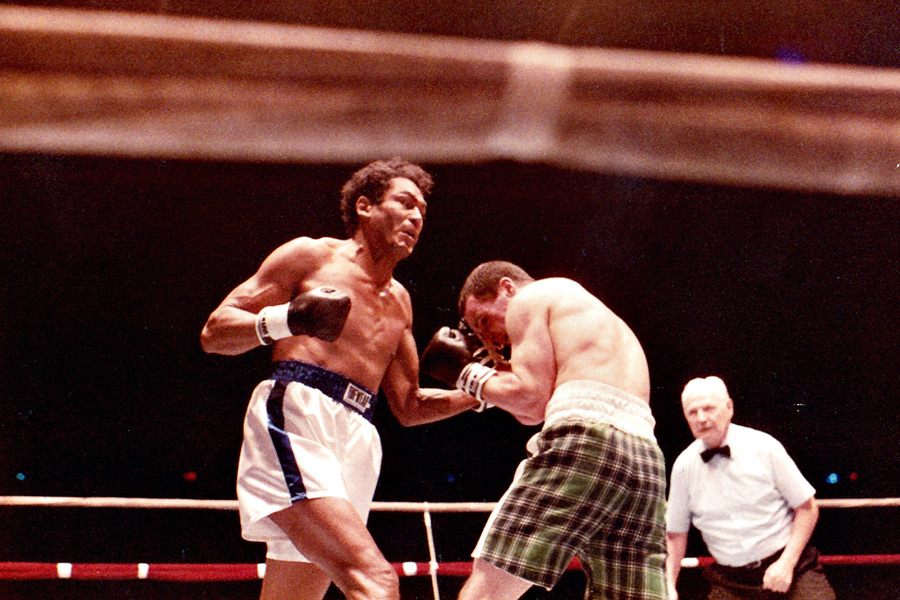Last week the World Boxing Council held its 52nd annual convention in Las Vegas celebrating the history of the sport and its former champions. Among the venerated lineup of decorated fighters was Marvin Camel, one of the all-time greats who emerged from the Flathead Indian Reservation in the 1970s and won two world titles in the cruiserweight division, battling among boxing icons such as Larry Holmes and Sugar Ray Leonard.
Camel is making a comeback of sorts thanks to a new biography by Brian D’Ambrosio released earlier this month by Riverbend Publishing. The Helena writer, who has published 10 books, spent the last two years talking with Camel, who now quietly lives in Florida, researching the full life of a true — and largely forgotten — Montana legend. The result is “Warrior in the Ring,” a gripping biography that shares the drama, danger and beauty of Camel’s inspirational story.
“We’re bringing Marvin and his unforgettable story back from the dead,” D’Ambrosio said last week, in an interview with the Beacon about his new book.
Flathead Beacon: How did you come across Marvin Camel and his story?
Brian D’Ambrosio: I was born and raised in New York and I grew up around boxing gyms. Boxing was one of the things I’ve always had a great affection and affinity for and I’ve always maintained a certain veneration for boxers and their stories. When I moved out to Montana in 2000 I started to hear the name Marvin Camel. I knew it from the cruiserweight division that was formed and I knew that there was this obscure guy who came from the Flathead Indian Reservation. I thought about it and thought about it and then in 2006, I ran into one of his siblings, Kenny, who was working at club boxing as a referee and I got Marvin’s phone number. I spoke to Marvin and after that, in the back of my mind I always wanted to do Marvin’s story. I always thought it would be arresting compelling and gripping.
Then I forgot about it for a couple years and moved to Wisconsin. But there was something calling me back, something incomplete or unfinished. I just knew Marvin’s story was it. It had to be told. So I just uprooted everything and came back to Montana two years ago and started work.
FB: Was there anything that surprised you along the way?
BD: I think what surprised me more than anything was just how much of a contrast Marvin is to many other former boxers. He just turned 64 (on Dec. 24). He’s robust. He’s vigorously healthy. He has all of his mental faculties in place. He’s jolly. He’s not embittered. When you contrast that with some of the men that Marvin fought, most of them are dead or incarcerated or homeless. I just heard a story that young Joe Louis, who was Marvin’s last fight, is in bad shape. He’s kind of wandering the streets of Chicago penniless. Marvin fought Matthew Saad Muhammad twice and Matthew was one of the great fighters of all time. He just died recently. I have his last interview in the book and he was in a homeless shelter in Philadelphia.
So some of the things along the journey were very surprising in good ways and bad ways… It’s a gritty book. It’s not just about boxing. It’s about Marvin’s upbringing and environment and overcoming obstacles and geography and isolation.
FB: Are you surprised that Marvin and his accomplishments are largely forgotten? Why do you think that is?
BD: It should be celebrated and it was. There was a Marvin Camel Day at one point. And he was given the key to the city in many places. This is a remarkable story of achievement. To do what Marvin did, to win two belts and the world titles in boxing, is just extraordinary … I think maybe the story is forgotten because it’s boxing and boxing’s glory days are over. And Marvin won a title in a new division. It wasn’t heavyweight or one of the more noted weight classes. It was also a new division. And I think because Marvin vanished. He hopped on his Yamaha scooter one day in ’83 and left Montana. And there’s sort of that separation and estrangement that’s never been healed or reconciled, even though many of his siblings are still living on the reservation and love him … It’s a story that really, really needs to be brought out because what Marvin did for the state of Montana transcends race and athletics and geography. And it’s just a beautiful story about one man overcoming so much and putting in the effort to be a world champion.
For more information about “Warrior in the Ring,” visit http://www.riverbendpublishing.com/warrior-in-the-ring.html
